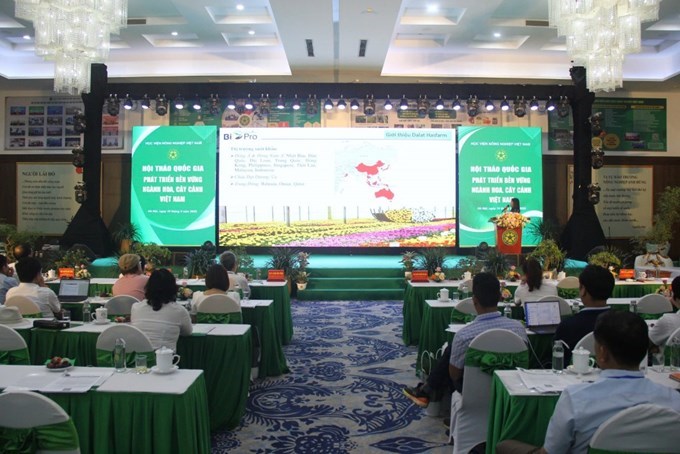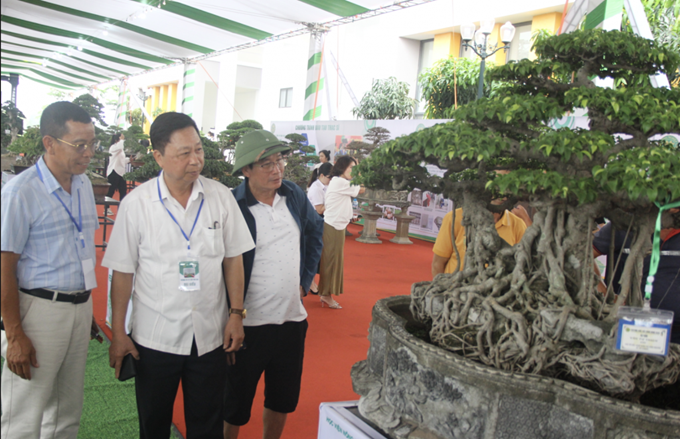On the afternoon of May 10, 2025, Vietnam National University of Agriculture (VNUA) held the National Conference on the Sustainable Development of Vietnam’s Flower and Ornamental Plant Industry. The event served as a forum for scientists, policymakers, businesses, artisans, and producers to come together and discuss strategies to promote the sustainable growth of Vietnam’s flower and ornamental plant sector.
Export Value Exceeds 100 Million USD Annually
Vietnam’s flower and ornamental plant industry not only added beauty to life and enriched living spaces with great spiritual value, but also played a significant role in agricultural economic development, creating jobs and providing income for millions of people.
    |
 |
| The event served as a forum for scientists, policymakers, businesses, artisans, and producers to share their experiences. |
In the context of international integration, occupational shifts, and climate change, the flower and ornamental plant industry was facing numerous challenges related to human resources, plant varieties, cultivation techniques, pest management, value chain linkages, and market access. The National Conference on the Sustainable Development of Vietnam’s Flower and Ornamental Plant Industry, organized by VNUA, attracted many innovative ideas, practical experiences, and strategic solutions for advancing education, scientific research, technology transfer, and market development in this field.
Speaking at the Conference, Prof. Dr. Pham Van Cuong, VNUA’s Vice President, noted that in recent years, Vietnam’s flower and ornamental plant industry had made impressive strides, becoming one of the most promising economic sectors. It not only contributed to increasing farmers’ incomes but also played an important role in new rural development, tourism, and urban cultural enhancement.
    |
 |
| Prof. Dr. Pham Van Cuong, VNUA’s Vice President, delivers a speech at the Conference |
As of 2024, Vietnam had nearly 45,000 hectares dedicated to growing flowers and ornamental plants, an eightfold increase compared to the year 2000. The industry's total annual production value exceeded 45 trillion VND. Flower export turnover had surpassed 100 million USD, with key products including orchids, roses, and chrysanthemums. That demonstrated the increasingly affirmed position of Vietnam’s flower and ornamental plant industry both regionally and globally.
Today’s Conference was expected to serve as an important academic and practical forum, bringing together ideas, innovations, research outcomes, and real-world experiences from scientists, artisans, policymakers, and businesses. Through presentations and discussions, participants aimed to explore and propose practical, comprehensive solutions to achieve the goal of sustainably developing the flower and ornamental plant industry.
Towards the Sustainable Development of Vietnam’s Flower and Ornamental Plant Industry
Although Vietnam’s flower and ornamental plant industry had seen significant growth in recent years, with the fresh flower market estimated at around USD 1.2 billion, there remained numerous challenges and difficulties in the domestic market.
According to Ms. Duong Thi Nga, Deputy Director of the Northern Center for Crop Production and Plant Protection (under the Department of Crop Production and Plant Protection), the industry currently faced a shortage of high-quality human resources, a lack of specialized researchers, and fragmented, uncoordinated applications of high technology, etc.
At the Conference, Mr. Nguyen Anh Tru, VNUA, also pointed out various concerns and challenges facing the industry today, including: (i) there remained unresolved issues in the planning and development of flower-growing regions; (ii) despite advancements, flower and ornamental cultivation techniques in Vietnam remained outdated compared to neighboring countries; (iii) most flower and ornamental plant varieties currently grown in Vietnam were imported through unofficial channels and lack intellectual property rights; (iv) the workforce for managing and operating high-tech flower production was still limited in both quantity and quality, with a low proportion of trained professionals; (v) there was intense competition in the global market; and (vi) there remained the ongoing impacts of climate change.
    |
 |
| Many artistic works highly praised by experts and scientists |
In response to the challenges mentioned above, and in order to build a sustainable, modern, environmentally friendly, and highly competitive flower and ornamental plant industry in Vietnam, Ms. Duong Thi Nga proposed several key solutions as follows.
In terms of science and technology, she emphasized the need to create favorable conditions for organizations and individuals to research, develop, and import new flower and ornamental plant varieties with novel traits that meet the increasingly high demands for beauty, cultural value, and usage purposes of both domestic and international customers. Additionally, she highlighted the importance of researching and perfecting production technologies across all stages—from propagation, planting, care, pruning, harvesting, pre-processing, to storage—while promoting the adoption of sustainable cultivation practices.
Regarding market development, Ms. Nga stressed the need to study the cultural habits of Vietnamese families in using flowers and ornamental plants, to diversify flower products to cater to various customer segments, and to research consumer cultures and preferences in potential markets such as China, Japan, and South Korea. She also recommended encouraging businesses to form partnerships with cooperatives to strengthen value chain linkages.
From a scientific research perspective, Mr. Nguyen Anh Tru noted that with Vietnam’s advantages in market demand, climate, soil, labor, technology, and supportive policies, the country’s flower production had the potential to meet the necessary requirements in terms of quantity, quality, and cost. These factors could help increase the competitiveness of Vietnamese flower and ornamental plant products on the global market.
“To sustainably develop Vietnam’s flower and ornamental plant industry, we must move toward high-tech production and food processing”, Mr. Tru emphasized. “In addition, we should focus on integrating flower and plant production with medicinal processing and essential oil extraction, as well as developing flower and ornamental plant production in association with eco-tourism and market expansion.”